Manila is the capital of the Philippines. With a population of 1,660,714 in 2006, Manila is the second most populous city in the Philippines behind Quezon City. With an estimated population of 16,300,000, Metro Manila is the most populous metropolitan area in the Philippines and the 11th in the world. The greater urban area is the 5th largest in the world with a population of 20,654,307 people.However, the populace inhabit an area of only 38.55 square kilometers, making Manila the most densely populated city in the world.
For hundreds of years, the walled city of Intramuros was Manila: the nerve center of the Spanish occupation in the Philippines, home to several thousand Spanish colonists, their families, and their Filipino servants.
Intramuros was erected on the ruins of a Malay settlement at the mouth of the Pasig River. Its strategic location attracted the attention of the conquistador Miguel Lopez de Legazpi, who took over the area in 1571 and proclaimed it as the Philippine colony's new capital.
For 400 years, Intramuros was the center of Spanish political, religious, and military power in the region. The walled city suffered grievously through World War II; only San Agustin Cathedral was left standing by war's end.
In the 1980s, the government led a major restoration effort that reconstructed Intramuros to its present state. Today, Intramuros is a prominent tourist spot where visitors can experience Spanish-era Manila through the walled city's churches, restaurants, and museums.
Monday, January 31, 2011
Sunday, January 30, 2011
El Nido (Palawan Island), Philippines- Bacuit Archipelago
El Nido is a coastal town in Palawan. El Nido composes of 45 islands and islets, limestone cliffs are also found here which form a Karst backdrop similar to those found in Ha Long Bay, Krabi and Guilin.
El Nido is a popular destination for locals during the long holidays of the Holy week, but it relatively unknown to foreign tourists. El Nido is more than just a stereotypical tropical paradise- Beaches, clear waters,jungle, sheer limestone cliffs and stunning inlets make for one of the world's most beautiful seascapes.
Before El Nido a popular tourist destination, fishing and harvesting swift nests "Nido" were the main source of income. Nowadays tourism has become the municipality's main source of revenue, however the authorities are keep to keep it sustainable and hotel chains are refreshingly absent.
Island hopping is the main pastime in the Bacuit Archipelago, along with exploring the numerous beaches here. El Nido is the main town in the region, from where visitors can charter a boat or get on a boat tour of the Bacuit Archipelago.
There is something like three-dozen islands to choose from, including the likes of Miniloc, Pangalusian, and Snake islands. Big Lagoon on Miniloc Island is a major highlight and is especially impressive during a full moon, while nearby Small Lagoon is perfect for the adventure type. Snake Island has the best sunbathing; Pangalusian superior snorkeling.
Closer to El Nido for those in search of a good beach are Commando Beach, Paradise Beach, and Lapus-Lapus Beach, all of which have fine sands and great coral for snorkeling.
El Nido is a popular destination for locals during the long holidays of the Holy week, but it relatively unknown to foreign tourists. El Nido is more than just a stereotypical tropical paradise- Beaches, clear waters,jungle, sheer limestone cliffs and stunning inlets make for one of the world's most beautiful seascapes.
Before El Nido a popular tourist destination, fishing and harvesting swift nests "Nido" were the main source of income. Nowadays tourism has become the municipality's main source of revenue, however the authorities are keep to keep it sustainable and hotel chains are refreshingly absent.
Island hopping is the main pastime in the Bacuit Archipelago, along with exploring the numerous beaches here. El Nido is the main town in the region, from where visitors can charter a boat or get on a boat tour of the Bacuit Archipelago.
There is something like three-dozen islands to choose from, including the likes of Miniloc, Pangalusian, and Snake islands. Big Lagoon on Miniloc Island is a major highlight and is especially impressive during a full moon, while nearby Small Lagoon is perfect for the adventure type. Snake Island has the best sunbathing; Pangalusian superior snorkeling.
Closer to El Nido for those in search of a good beach are Commando Beach, Paradise Beach, and Lapus-Lapus Beach, all of which have fine sands and great coral for snorkeling.
El Nido (Palawan Island), Philippines- Bacuit Archipelago
El Nido is a coastal town in Palawan. El Nido composes of 45 islands and islets, limestone cliffs are also found here which form a Karst backdrop similar to those found in Ha Long Bay, Krabi and Guilin.
El Nido is a popular destination for locals during the long holidays of the Holy week, but it relatively unknown to foreign tourists. El Nido is more than just a stereotypical tropical paradise- Beaches, clear waters,jungle, sheer limestone cliffs and stunning inlets make for one of the world's most beautiful seascapes.
Before El Nido a popular tourist destination, fishing and harvesting swift nests "Nido" were the main source of income. Nowadays tourism has become the municipality's main source of revenue, however the authorities are keep to keep it sustainable and hotel chains are refreshingly absent.
Island hopping is the main pastime in the Bacuit Archipelago, along with exploring the numerous beaches here. El Nido is the main town in the region, from where visitors can charter a boat or get on a boat tour of the Bacuit Archipelago.
There is something like three-dozen islands to choose from, including the likes of Miniloc, Pangalusian, and Snake islands. Big Lagoon on Miniloc Island is a major highlight and is especially impressive during a full moon, while nearby Small Lagoon is perfect for the adventure type. Snake Island has the best sunbathing; Pangalusian superior snorkeling.
Closer to El Nido for those in search of a good beach are Commando Beach, Paradise Beach, and Lapus-Lapus Beach, all of which have fine sands and great coral for snorkeling.
El Nido is a popular destination for locals during the long holidays of the Holy week, but it relatively unknown to foreign tourists. El Nido is more than just a stereotypical tropical paradise- Beaches, clear waters,jungle, sheer limestone cliffs and stunning inlets make for one of the world's most beautiful seascapes.
Before El Nido a popular tourist destination, fishing and harvesting swift nests "Nido" were the main source of income. Nowadays tourism has become the municipality's main source of revenue, however the authorities are keep to keep it sustainable and hotel chains are refreshingly absent.
Island hopping is the main pastime in the Bacuit Archipelago, along with exploring the numerous beaches here. El Nido is the main town in the region, from where visitors can charter a boat or get on a boat tour of the Bacuit Archipelago.
There is something like three-dozen islands to choose from, including the likes of Miniloc, Pangalusian, and Snake islands. Big Lagoon on Miniloc Island is a major highlight and is especially impressive during a full moon, while nearby Small Lagoon is perfect for the adventure type. Snake Island has the best sunbathing; Pangalusian superior snorkeling.
Closer to El Nido for those in search of a good beach are Commando Beach, Paradise Beach, and Lapus-Lapus Beach, all of which have fine sands and great coral for snorkeling.
Saturday, January 29, 2011
Batad, Philippines - Rice Terraces
In the fastness of the Cordillera mountains, 250-km north of Manila, Ifugao tribespeople have carved a livelihood from bare rock. Over the centuries, generations of Ifugao have laid stone after stone constructing dikes to hold back what little soil washed off the mountainsides creating vertical gardens that rise as "stairways to the heavens."
Rice terraces are common throughout Asia but nowhere are they as spectacular as in the rugged mountains of northern Luzon. The Ifugaos have resisted integration into mainstream society and still practice their traditional farming and religion although headhunting is on the wane.
Batad is a place to reflect, gaze, wonder at the beauty of it all and bask in the pleasure of having such a place on this earth. A tour of the mountainous region of Northern Luzon is not complete without a visit there.
The Batad Rice Terraces are 2000-year old terraces that were carved into the mountains of Ifugao in the Philippines by ancestors of the indigenous people. The Rice Terraces are commonly referred to by Filipinos as the "Eighth Wonder of the World". It is commonly thought that the terraces were built with minimal equipment, largely by hand. The terraces are located approximately 1500 meters above sea level and cover 10,360 square kilometers of mountainside. They are fed by an ancient irrigation system from the rainforests above the terraces. It is said that if the steps are put end to end it would encircle half the globe.
The Batad Rice Terraces are inscribed as a UNESCO World Heritage Site. Locals to this day still plant rice and vegetables on the terraces, although more and more younger Ifugaos do not find farming appealing, often opting for the more lucrative hospitality industry generated by the Rice Terraces. The result is the gradual erosion of the characteristic "steps", which need constant reconstruction and care.
Rice terraces are common throughout Asia but nowhere are they as spectacular as in the rugged mountains of northern Luzon. The Ifugaos have resisted integration into mainstream society and still practice their traditional farming and religion although headhunting is on the wane.
Batad is a place to reflect, gaze, wonder at the beauty of it all and bask in the pleasure of having such a place on this earth. A tour of the mountainous region of Northern Luzon is not complete without a visit there.
The Batad Rice Terraces are 2000-year old terraces that were carved into the mountains of Ifugao in the Philippines by ancestors of the indigenous people. The Rice Terraces are commonly referred to by Filipinos as the "Eighth Wonder of the World". It is commonly thought that the terraces were built with minimal equipment, largely by hand. The terraces are located approximately 1500 meters above sea level and cover 10,360 square kilometers of mountainside. They are fed by an ancient irrigation system from the rainforests above the terraces. It is said that if the steps are put end to end it would encircle half the globe.
The Batad Rice Terraces are inscribed as a UNESCO World Heritage Site. Locals to this day still plant rice and vegetables on the terraces, although more and more younger Ifugaos do not find farming appealing, often opting for the more lucrative hospitality industry generated by the Rice Terraces. The result is the gradual erosion of the characteristic "steps", which need constant reconstruction and care.
Subscribe to:
Posts (Atom)


